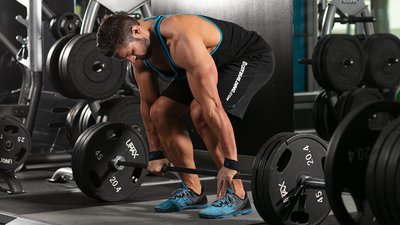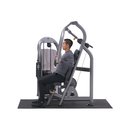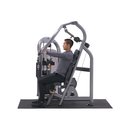Q. My split has both a heavy workout and a lighter hypertrophy day each week. But I feel like I'm not recovered enough for today's heavy push routine. Should I gut it out?
If you've been following my work here on Bodybuilding.com, you know that I'm a fan of nonlinear periodization plans like yours. You can read more about it in my previous articles or in my Project Mass 14-week muscle-building trainer, but the upshot is that you can effectively train the same body part multiple times a week, as long as you vary the intensity of the workouts.
Most people take the next step and program their week out fairly strictly. For example, heavy lifting on Monday, hypertrophy shock on Wednesday, and light hypertrophy work on Friday.
But what happens when you go into Wednesday and feel awful? The warrior inside of us says to stop being a pansy and push through it. But is that the right thing to do?
Our lab has looked into this question recently, and the answer may surprise you. Read on to become a more aware lifter—and a bigger and stronger one to boot!
How strong do you feel today?
That's the question that guided Dr. McNamara and his colleagues in what I consider a landmark experiment back in 2010.1 They divided subjects into two groups: "flexible" and "nonflexible" periodization. All subjects had three training sessions consisting of a heavy day, a hypertrophy day, and a light recovery day.
The nonflexible group had to perform workouts on assigned days, whereas the flexible group trained according to how they felt—as long as they got in all three workouts during the week.

{{caption}}
Having a plan that interacts with how an athlete is feeling on a given day is preferable over a set schedule.
Thus, if the flexible group felt weak and under-recovered on Wednesday, they would select the lightest day. If they felt amazing on Monday, they would select the heaviest day. The results showed that even though subjects all performed the same workouts, the flexible group increased their leg strength by 60 pounds, whereas the nonflexible group only increased it by 20 pounds!
This flexible style of training is known as "autoregulatory training." The implication here seems pretty clear: Having a plan that interacts with how an athlete is feeling on a given day is preferable over a set schedule.
On a scale of 1-10, how recovered are you?
Our lab has recently conducted two experiments on autoregulatory training. The first was published last year, but no one knows about the second one except you, the Bodybuilding.com faithful!
In our first study, we utilized a system called the "perceived recovery status" scale, or PRS.2 The PRS scale matches up how recovered athletes feel with what type of performance they can expect in the gym.
In our first study, we took highly resistance-trained guys and subjected them to an average training volume of 40,000 pounds per workout—pretty rough stuff. We asked them their PRS both before training, and 48 hours after, when they were expected to train again.
We found large drops in their PRS, but just as importantly, we saw that these changes could predict changes in performance, testosterone levels, and direct measures of muscle damage. In our minds, this proved the validity of the scale. The next step, then, was to put PRS to the test over the course of an entire microcycle.
Our newest study used 40 bodybuilders and powerlifters who could squat over 2 times their bodyweight and bench over 1.5 times their bodyweight—in other words, not your average untrained college students. These were big, strong guys. We then put them through two weeks of hell in which we had them lift nearly 200,000 pounds a week. This is known as an overreaching cycle—and if you started following Project Mass when it came out in November 2014, you know what I'm talking about.
After two brutally hard weeks, we then tapered them for two weeks and dialed down their training—which again, lines up with how Project Mass is structured. During this time, we monitored the athletes' strength, muscle damage, and cortisol levels. We also looked at their muscle mass directly using our ultrasound.

{{caption}}
Those days where you enter the gym feeling like absolute trash—i.e., below 5—is not the time to be tough and try to up the volume.
We found that after the two-week overreach, those individuals whose PRS only dropped down to a 7 out of 10 had rebounded drastically. They gained both muscle mass and decreased fat mass, and they also got stronger! However, those who dropped to a 5-6 only recovered to baseline after the two-week taper. This means they were right back where they started. And if the athlete dropped below 5, they didn't even recover to baseline values, meaning they actually lost size and strength.
This was absolutely breakthrough research to us. It means that those days where you enter the gym feeling like absolute trash—i.e., below 5—is not the time to be tough and try to up the volume. While I certainly take my hat off to you for having the guts to do that, it would be in your best interests to select a low-volume recovery workout for that day.
Making autoregulatory training work for you
Once you have a periodized plan based on your goals, you need to allow for flexibility. I recommend utilizing a light recovery day, a moderate day, and a very hard day in any given week for whatever body part you're looking to bring up.
During the week, you'll need to get each of these workouts in, and you'll select these workouts based on your perceived recovery. If you're at 8-10, hit the hard day. If you're at 7, select the moderate day. If, however, you are below this, select the recovery day.
What would a recovery workout look like, you ask? Repetitions are between 12-15, and movements are machine- and isolation-based. For example, instead of squats you would do leg press, leg extensions, and leg curls. I would recommend 3 sets of a less stressful compound movement, and another three sets of 1-2 isolation movements for a total of 9-12 sets.

{{caption}}
What would a recovery workout look like, you ask? Repetitions are between 12-15, and movements are machine- and isolation-based.
Here's how it could look for chest and shoulders:

BodyFit
$6.99/month- 2,500+ expert-created single workouts
- 3,500+ how-to exercise videos
- Detailed workout instruction
- Step-by-step workout tips
- Training at gym or at home
- Access to Workout Plans
- Access to Bodyfit App
- Store Discounts
Already have a Bodybuilding.com account with BodyFit? Sign In

What comes with BodyFit?

- Instructional Videos
Don't risk doing a workout improperly! Avoid injury and keep your form in check with in-depth instructional videos.

- How-to Images
View our enormous library of workout photos and see exactly how each exercise should be done before you give it a shot.

- Step-by-Step Instructions
Quickly read through our step-by-step directions to ensure you're doing each workout correctly the first time, every time.
If you find yourself below 7 on the PRS scale for the whole week, it's time to cut your volume down by 50-80 percent for the next 1-2 weeks. This means that if you normally do 10 sets of legs, you will only do 2-5 sets for two weeks until your PRS is back in the range where you need it to be.
Plato probably had no idea that his famous dictum "know thyself" would one day be applied to getting huge and shredded, but that's exactly what our lab has found. So here's my rebuttal to the great philosopher: Know thyself so you can grow thyself!
References
- McNamara, J. M., & Stearne, D. J. (2010). Flexible nonlinear periodization in a beginner college weight training class. The Journal of Strength & Conditioning Research, 24(8), 2012-2017.
- Sikorski, E. M., Wilson, J. M., Lowery, R. P., Joy, J. M., Laurent, C. M., Wilson, S. M., ... & Gilchrist, P. (2013). Changes in perceived recovery status scale following high-volume muscle damaging resistance exercise. The Journal of Strength & Conditioning Research, 27(8), 2079-2085.




